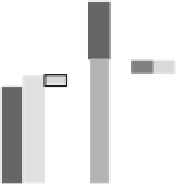Geoscience Reference
In-Depth Information
(c)
(a)
(b)
(d)
Figure 9.39.
A diagram illustrating the evolution to topography and the lithospheric
age distribution for a right-lateral transform fault: (a) simple model; (b), (c) and (d)
progressive evolution when the ridge shown in (a) propagates and recesses. Dashed
lines mark the extent of the fracture zone. At any one time the active transform fault
would link the termination of the ridge segments. By time (d), it is clear that, near the
active transform, the age of the lithosphere and the faulting are very complicated
and that many old small lithospheric blocks are retained there. (From Goud and
Karson (1986).)
any fault. In the fast-slipping example, the lithosphere is much thinner, so it is
much easier for a wide shear-zone system to develop. Detailed studies of the Mid-
Atlantic Ridge have been made in the FAMOUS area, which includes a number
of short-offset (
20 km) transform faults. Two of these transform faults, A and B,
which are at opposite ends of a 50-km ridge segment, illustrate the inadvisability
of generalization. They are similar in terms of their broad structure (Table 9.4),
but results of detailed submersible studies of morphology, faulting, location of
scarps and exposures of fresh volcanic material show that transform fault A looks
very like the large-offset slow-slipping model of Fig. 9.34 with faulting confined
to a narrow zone, whereas in transform fault B, shear deformation is occurring
across a wide (
∼
6 km) zone. Interpretations of the bathymetry and magnetics
support these observations and suggest that, at transform fault B, the ridge may
well have undergone propagation and recession in the past (instability in the
location of the PTDZ), giving rise to the more complicated structure observed
there. Figure 9.39 shows schematically such an unstable PTDZ.
The thinner than normal crust in the fracture zones and the gradual thinning
of the crust over some tens of kilometres towards the fracture zones, as illustrated
for the Atlantic in Fig. 9.37, are thought to be the result of generalization of
two effects. The old, cold lithosphere juxtaposed against the ridge axis has a
significant thermal effect on the magma supply and tectonics. Thermal modelling
>





































































